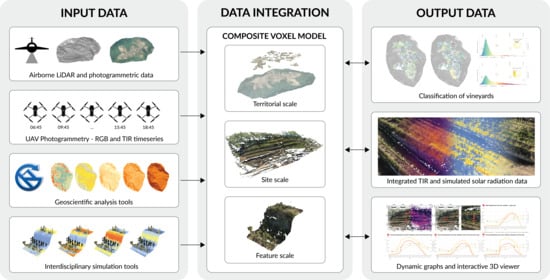Integration of Remote Sensing Data into a Composite Voxel Model for Environmental Performance Analysis of Terraced Vineyards in Tuscany, Italy
Abstract
:1. Introduction
2. Materials and Methods
2.1. Remote Sensing Data Acquisition
2.1.1. Airborne LiDAR and Photogrammetric Flight
2.1.2. Visible and Thermal Infrared Flights of Unmanned Aerial Vehicle (UAV)
2.2. Field Data Collection and Open-Access Geographic Information Systems (GIS) Data
2.2.1. Field Data Collection
2.2.2. Open-Access Geographic Information Systems (GIS) Data
2.3. Composite Voxel Model (CVM)
3. Results
3.1. Remote Sensing Data Integration
3.1.1. Territorial Scale
3.1.2. Site and Feature Scale
3.2. Open-Access Geographic Information Systems (GIS) Data and Field Data Integration
3.2.1. Territorial Scale
3.2.2. Site and Feature Scales
3.3. Environmental Performance Simulations
3.3.1. Territorial Scale
3.3.2. Site Scale
3.3.3. Feature Scale
3.4. Composite Voxel Model (CVM))
3.4.1. Territorial Scale
3.4.2. Site Scale
3.4.3. Feature Scale
3.4.4. Structure of the Composite Voxel Model (CVM)
4. Discussion
4.1. Development of the Composite Voxel Models (CVMs) through Further Surveys
4.2. General Development of Composite Voxel Models (CVMs) and Related Workflows
4.3. The Bigger Picture: Decision Support for Land Knowledge Utilization
5. Conclusions
Supplementary Materials
Author Contributions
Funding
Data Availability Statement
Acknowledgments
Conflicts of Interest
References
- Pretty, J. Interdisciplinary progress in approaches to address social-ecological and ecocultural systems. Environ. Conserv. 2011, 38, 127–139. [Google Scholar] [CrossRef] [Green Version]
- Sunderland, T.; Abdoulaye, R.; Ahammad, R.; Asaha, S.; Baudron, F.; Deakin, E.; Duriaux, J.-Y.; Eddy, I.; Foli, S.; Gumbo, D.; et al. A methodological approach for assessing cross-site landscape change: Understanding socio-ecological systems. For. Policy Econ. 2017, 84, 83–91. [Google Scholar] [CrossRef]
- Zscheischler, J.; Rogga, S.; Busse, M. The adoption and implementation of transdisciplinary research in the field of land-use science—A comparative case study. Sustainability 2017, 9, 1926. [Google Scholar] [CrossRef] [Green Version]
- UNESCO. Intergovernmental Committee for the Safeguarding of the Intangible Cultural Heritage Decision of the Intergovernmental Committee: 13.COM 10.B.10 2018. Available online: https://ich.unesco.org/en/decisions/13.COM/10.B.10 (accessed on 15 July 2021).
- FAO. GIHAS, Globally Important Agricultural Heritage Systems. Available online: http://www.fao.org/giahs/background/a-global-partnership/en/ (accessed on 3 January 2021).
- Varotto, M.; Bonardi, L.; Tarolli, P. World Terraced Landscapes: History, Environment, Quality of Life; Springer: Cham, Switzerland, 2019; ISBN 978-3-319-96815-5. [Google Scholar]
- Agnoletti, M.; Conti, L.; Frezza, L.; Monti, M.; Santoro, A. Features analysis of dry stone walls of Tuscany (Italy). Sustainability 2015, 7, 13887–13903. [Google Scholar] [CrossRef] [Green Version]
- Agnoletti, M.; Conti, L.; Frezza, L.; Santoro, A. Territorial analysis of the agricultural terraced landscapes of Tuscany (Italy): Preliminary Results. Sustainability 2015, 7, 4564–4581. [Google Scholar] [CrossRef] [Green Version]
- Spanò, A.; Sammartano, G.; Tunin, F.C.; Cerise, S.; Possi, G. GIS-based detection of terraced landscape heritage: Comparative tests using regional DEMs and UAV data. Appl. Geomat. 2018, 10, 77–97. [Google Scholar] [CrossRef] [Green Version]
- Stubert, L.; Martín i Oliveras, A.; Märker, M.; Schernthanner, H.; Vogel, S. Viticulture in the Laetanian Region (Spain) during the Roman Period: Predictive modelling and geomatic analysis. Geosciences 2020, 10, 206. [Google Scholar] [CrossRef]
- Tarolli, P.; Preti, F.; Romano, N. Terraced landscapes: From an old best practice to a potential hazard for soil degradation due to land abandonment. Anthropocene 2014, 6, 10–25. [Google Scholar] [CrossRef]
- Agnoletti, M.; Errico, A.; Santoro, A.; Dani, A.; Preti, F. Terraced landscapes and hydrogeological risk. Effects of land abandonment in Cinque Terre (Italy) during severe rainfall events. Sustainability 2019, 11, 235. [Google Scholar] [CrossRef] [Green Version]
- Preti, F.; Tarolli, P.; Dani, A.; Calligaro, S.; Prosdocimi, M. LiDAR derived high resolution topography: The next challenge for the analysis of terraces stability and vineyard soil erosion. J. Agric. Eng. 2013, 44. [Google Scholar] [CrossRef]
- Preti, F.; Guastini, E.; Penna, D.; Dani, A.; Cassiani, G.; Boaga, J.; Deiana, R.; Romano, N.; Nasta, P.; Palladino, M.; et al. Conceptualization of water flow pathways in agricultural terraced landscapes. Land Degrad. Dev. 2018, 29, 651–662. [Google Scholar] [CrossRef]
- Tarolli, P.; Sofia, G.; Calligaro, S.; Prosdocimi, M.; Preti, F.; Dalla Fontana, G. Vineyards in terraced landscapes: New opportunities from Lidar Data. Land Degrad. Dev. 2015, 26, 92–102. [Google Scholar] [CrossRef]
- Pijl, A.; Reuter, L.E.H.; Quarella, E.; Vogel, T.A.; Tarolli, P. GIS-based soil erosion modelling under various steep-slope vineyard practices. Catena 2020, 193, 104604. [Google Scholar] [CrossRef]
- Pijl, A.; Quarella, E.; Vogel, T.A.; D’Agostino, V.; Tarolli, P. Remote sensing vs. field-based monitoring of agricultural terrace degradation. Int. Soil Water Conserv. Res. 2021, 9, 1–10. [Google Scholar] [CrossRef]
- Preti, F.; Errico, A.; Caruso, M.; Dani, A.; Guatsini, E. Dry-stone wall terrace monitoring and modelling. Land Degrad. Dev. 2018, 29, 1806–1818. [Google Scholar] [CrossRef]
- Hensel, M.; Sunguroğlu Hensel, D.; Sørensen, S.S. Embedded Architectures: Inquiries into architectures, diffuse heritage and natural environments in search for better informed design approaches to sustainability. Time Archit. 2018, 3, 42–45. [Google Scholar]
- Tucci, G.; Parisi, E.I.; Castelli, G.; Errico, A.; Corongiu, M.; Sona, G.; Viviani, E.; Bresci, E.; Preti, F. Multi-sensor UAV application for thermal analysis on a dry-stone terraced vineyard in rural Tuscany landscape. Int. J. Geo-Inf. 2019, 8, 87. [Google Scholar] [CrossRef] [Green Version]
- Parisi, E.; Suma, M.; Korumaz, A.G.; Rosina, E.; Tucci, G. Aerial Platforms (UAV) Surveys in the VIS and TIR range. Applications on archaeology and agriculture. Int. Arch. Photogramm. Remote. Sens. Spat. Inf. 2019, XLII-2/W11, 945–952. [Google Scholar] [CrossRef] [Green Version]
- Parisi, E.I.; Tyc, J. Multi-scale and multi-domain approaches for cultural terraced landscapes. In Proceedings of the ARQUEOLÓGICA 2.0—9th International Congress & 3rd GEORES—GEOmatics and pREServation, Editorial Universitat Politècnica de València, València, Spain, 26 April 2021; pp. 317–324. [Google Scholar] [CrossRef]
- Rupnik, E.; Daakir, M.; Pierrot Deseilligny, M. MicMac–a free, open-source solution for photogrammetry. Open Geospat. Data Softw. Stand. 2017, 2, 14. [Google Scholar] [CrossRef]
- Schönberger, J.L.; Frahm, J. Structure-from-motion revisited. In Proceedings of the 2016 IEEE Conference on Computer Vision and Pattern Recognition (CVPR), Las Vegas, NV, USA, 27–30 June 2016; pp. 4104–4113. [Google Scholar] [CrossRef]
- Schönberger, J.L.; Price, T.; Sattler, T.; Frahm, J.-M.; Pollefeys, M. A Vote-and-Verify Strategy for Fast Spatial Verification in Image Retrieval. In Computer Vision—ACCV 2016. Lecture Notes in Computer Science; Lai, S.H., Lepetit, V., Nishino, K., Sato, Y., Eds.; Springer: Cham, Switzerland, 2017; pp. 321–337. ISBN 978-3-319-54180-8. [Google Scholar]
- Kelly, J.; Kljun, N.; Olsson, P.-O.; Mihai, L.; Liljeblad, B.; Weslien, P.; Klemedtsson, L.; Eklundh, L. Challenges and best practices for deriving temperature data from an uncalibrated UAV thermal infrared camera. Remote Sens. 2019, 11, 567. [Google Scholar] [CrossRef] [Green Version]
- Tang, H.; Swatantran, A.; Barrett, T.; DeCola, P.; Dubayah, R. Voxel-based spatial filtering method for canopy height retrieval from airborne single-photon Lidar. Remote Sens. 2016, 8, 771. [Google Scholar] [CrossRef] [Green Version]
- Brolly, G.; Király, G.; Lehtomäki, M.; Liang, X. Voxel-based automatic tree detection and parameter retrieval from terrestrial laser scans for plot-wise forest inventory. Remote Sens. 2021, 13, 542. [Google Scholar] [CrossRef]
- Li, S.; Dai, L.; Wang, H.; Wang, Y.; He, Z.; Lin, S. Estimating leaf area density of individual trees using the point cloud segmentation of terrestrial LiDAR Data and a voxel-based model. Remote Sens. 2017, 9, 1202. [Google Scholar] [CrossRef] [Green Version]
- Consortium Project Pantheon Project—Supervisory Control and Data Acquisition (SCADA) System for the Precision Farming of Hazelnut Orchards. Available online: http://pantheon.inf.uniroma3.it/ (accessed on 19 March 2021).
- Lamprecht, S. Pyoints: A Python package for point cloud, voxel and raster processing. J. Open Source Softw. 2019, 4, 990. [Google Scholar] [CrossRef]
- Carpio, R.F.; Potena, C.; Maiolini, J.; Ulivi, G.; Rosselló, N.B.; Garone, E.; Gasparri, A. A navigation architecture for Ackermann vehicles in precision farming. IEEE Robot. Autom. Lett. 2020, 5, 1103–1110. [Google Scholar] [CrossRef]
- Jurado, J.M.; Ortega, L.; Cubillas, J.J.; Feito, F.R. Multispectral mapping on 3D models and multi-temporal monitoring for individual characterization of olive trees. Remote Sens. 2020, 12, 1106. [Google Scholar] [CrossRef] [Green Version]
- QGIS Geographic Information System. Open Source Geospatial Foundation Project. 2021. Available online: http://qgis.org (accessed on 15 July 2021).
- Conrad, O.; Bechtel, B.; Bock, M.; Dietrich, H.; Fischer, E.; Gerlitz, L.; Wehberg, J.; Wichmann, V.; Böhner, J. System for Automated Geoscientific Analyses (SAGA) v. 2.1.4. Geosci. Model Dev. 2015, 8, 1991–2007. [Google Scholar] [CrossRef] [Green Version]
- Zhao, Q.; Wentz, E.A. A MODIS/ASTER airborne simulator (MASTER) imagery for urban heat island research. Data 2016, 1, 7. [Google Scholar] [CrossRef] [Green Version]
- Kopp, S.; Becker, P.; Doshi, A.; Wright, D.J.; Zhang, K.; Xu, H. Achieving the full vision of earth observation data cubes. Data 2019, 4, 94. [Google Scholar] [CrossRef] [Green Version]
- Dask: Scalable analytics in Python. Anaconda Inc. and Contributors. 2021. Available online: https://dask.org (accessed on 15 July 2021).
- Hoyer, S.; Hamman, J. Xarray: N-D labeled arrays and datasets in Python. J. Open Res. Softw. 2017, 5, 10. [Google Scholar] [CrossRef] [Green Version]
- Pedregosa, F.; Varoquaux, G.; Gramfort, A.; Michel, V.; Thirion, B.; Grisel, O.; Blondel, M.; Prettenhofer, P.; Weiss, R.; Dubourg, V.; et al. Scikit-Learn: Machine Learning in Python. J. Mach. Learn. Res. 2011, 12, 2825–2830. [Google Scholar]
- Toja-Silva, F.; Lopez-Garcia, O.; Peralta, C.; Navarro, J.; Cruz, I. An empirical–heuristic optimization of the building-roof geometry for urban wind energy exploitation on high-rise buildings. Appl. Energy 2016, 164, 769–794. [Google Scholar] [CrossRef]
- Vuorinen, V.; Chaudhari, A.; Keskinen, J.-P. Large-eddy simulation in a complex hill terrain enabled by a compact fractional step OpenFOAM® solver. Adv. Eng. Softw. 2015, 79, 70–80. [Google Scholar] [CrossRef]
- Roudsari, M.S.; Pak, M.; Smith, A.; Gill, G. Ladybug: A parametric environmental plugin for grasshopper to help designers create an environmentally-conscious design. In Proceedings of the 13th Conference of International Building Performance Simulation Association (BS2013), Chambery, France, 26 August 2013; pp. 3128–3135. [Google Scholar]
- Böhner, J.; Antonić, O. Chapter 8 Land-surface parameters specific to topo-climatology. Dev. Soil Sci. 2009, 33, 195–226. [Google Scholar] [CrossRef]
- Wilson, J.P.; Gallant, J.C. Secondary topographic attributes. In Terrain Analysis: Principles and Applications; Wilson, J.P., Gallant, J.C., Eds.; John Wiley and Sons: New York, NY, USA; pp. 87–131. ISBN 978-0-471-32188-0.
- Hofierka, J.; Suri, M. The solar radiation model for open source GIS: Implementation and applications. In Proceedings of the Open Source GIS-GRASS Users Conference, Trento, Italy, 11–13 September 2002; pp. 51–70. [Google Scholar]
- Massari, G.; Massari, I. Damp buildings, old and new. Bull. Assoc. Preserv. Technol. 1985, 17, 2–30. [Google Scholar] [CrossRef]
- Brodu, N.; Lague, D. 3D terrestrial LiDAR data classification of complex natural scenes using a multi-scale dimensionality criterion: Applications in geomorphology. ISPRS J. Photogramm. Remote. Sens. 2012, 68, 121–134. [Google Scholar] [CrossRef] [Green Version]
- Weinmann, M.; Jutzi, B.; Hinz, S.; Mallet, C. Semantic point cloud interpretation based on optimal neighborhoods, relevant features and efficient classifiers. ISPRS J. Photogramm. Remote. Sens. 2015, 105, 286–304. [Google Scholar] [CrossRef]
- Raphaël Delhome; Damien Garaud; Romain Leroux-Mallouf geo3dfeatures. 2021. Available online: https://gitlab.com/Oslandia/geo3dfeatures/ (accessed on 12 July 2021).
- Bürgi, M.; Bieling, C.; von Hackwitz, K.; Kizos, T.; Lieskovský, J.; Martín, M.G.; McCarthy, S.; Müller, M.; Palang, H.; Plieninger, T.; et al. Processes and driving forces in changing cultural landscapes across Europe. Landsc. Ecol. 2017, 32, 2097–2112. [Google Scholar] [CrossRef] [Green Version]
- Chase, A.F.; Chase, D.Z.; Weishampel, J.F.; Drake, J.B.; Shrestha, R.L.; Slatton, K.C.; Awe, J.J.; Carter, W.E. Airborne LiDAR, archaeology, and the ancient Maya landscape at Caracol, Belize. J. Archaeol. Sci. 2011, 38, 387–398. [Google Scholar] [CrossRef]
- Chase, A.F.; Chase, D.Z. Scale and intensity in classic period Maya agriculture: Terracing and settlement at the ‘Garden City’ of Caracol, Belize. Cult. Agric. 1998, 20, 60–77. [Google Scholar] [CrossRef]
- Koohafkan, P.; Altieri, M. Forgotten Agricultural Heritage: Reconnecting Food Systems and Sustainable Development; Routledge: Milton Park, UK, 2016; ISBN 9781138204157. [Google Scholar]
- Sprague, R.H., Jr. A Framework for the Development of Decision Support Systems. MIS Q. 1980, 4, 1–26. [Google Scholar] [CrossRef]
- Perini, A.; Susi, A. Developing a decision support system for integrated production in agriculture. Environ. Model. Softw. 2004, 19, 821–829. [Google Scholar] [CrossRef]
- Rose, D.C.; Sutherland, W.J.; Parker, C.; Lobley, M.; Winter, M.; Morris, C.; Twining, S.; Ffoulkes, C.; Amano, T.; Dicks, L.V. Decision support tools for agriculture: Towards effective design and delivery. Agric. Syst. 2016, 149, 165–174. [Google Scholar] [CrossRef] [Green Version]
- Zhai, Z.; Martínez, J.F.; Beltran, V.; Martínez, N.L. Decision support systems for agriculture 4.0: Survey and challenges. Comput. Electron. Agric. 2020, 170, 105256. [Google Scholar] [CrossRef]
- Castrignano, A.; Buttafuoco, G.; Khosla, R.; Mouazen, A.; Moshou, D.; Naud, O. Agricultural Internet of Things and Decision Support. for Precision Smart Farming, 1st ed.; Academic Press-Elsevier: Cambridge, MA, USA, 2020; ISBN 9780128183731. [Google Scholar]
- Sunguroğlu Hensel, D. Ecological Prototypes: Initiating design innovation in Green Construction. Sustainability 2020, 12, 5865. [Google Scholar] [CrossRef]
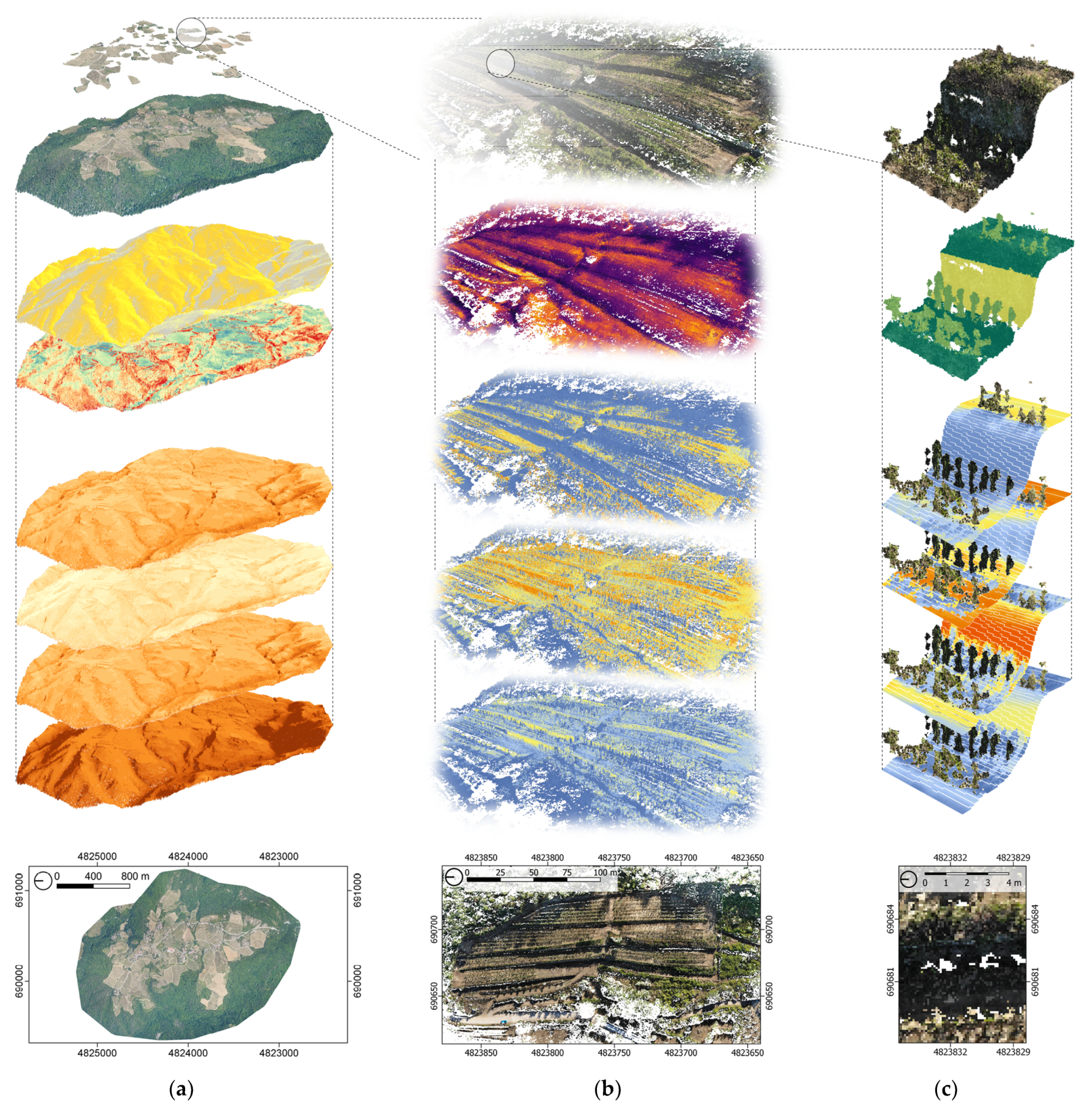
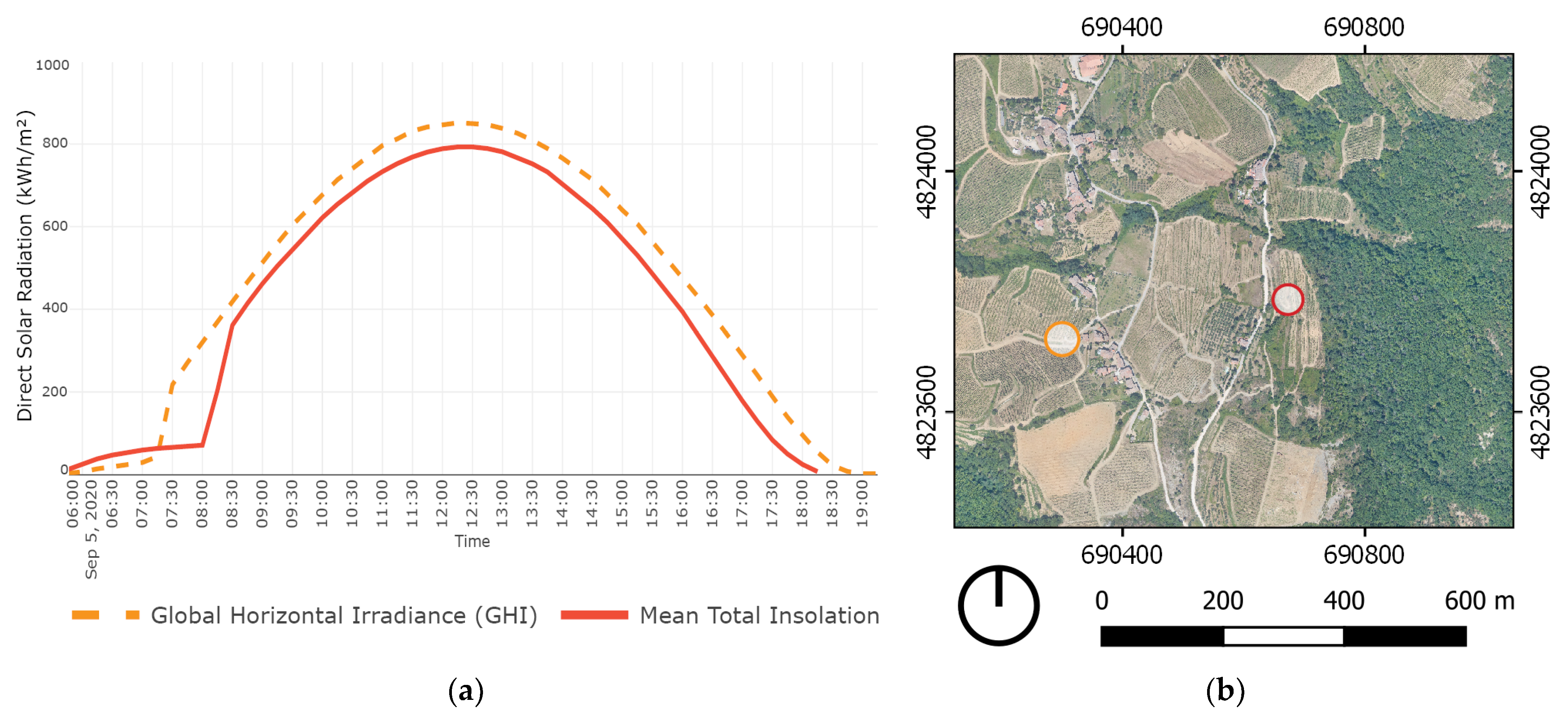
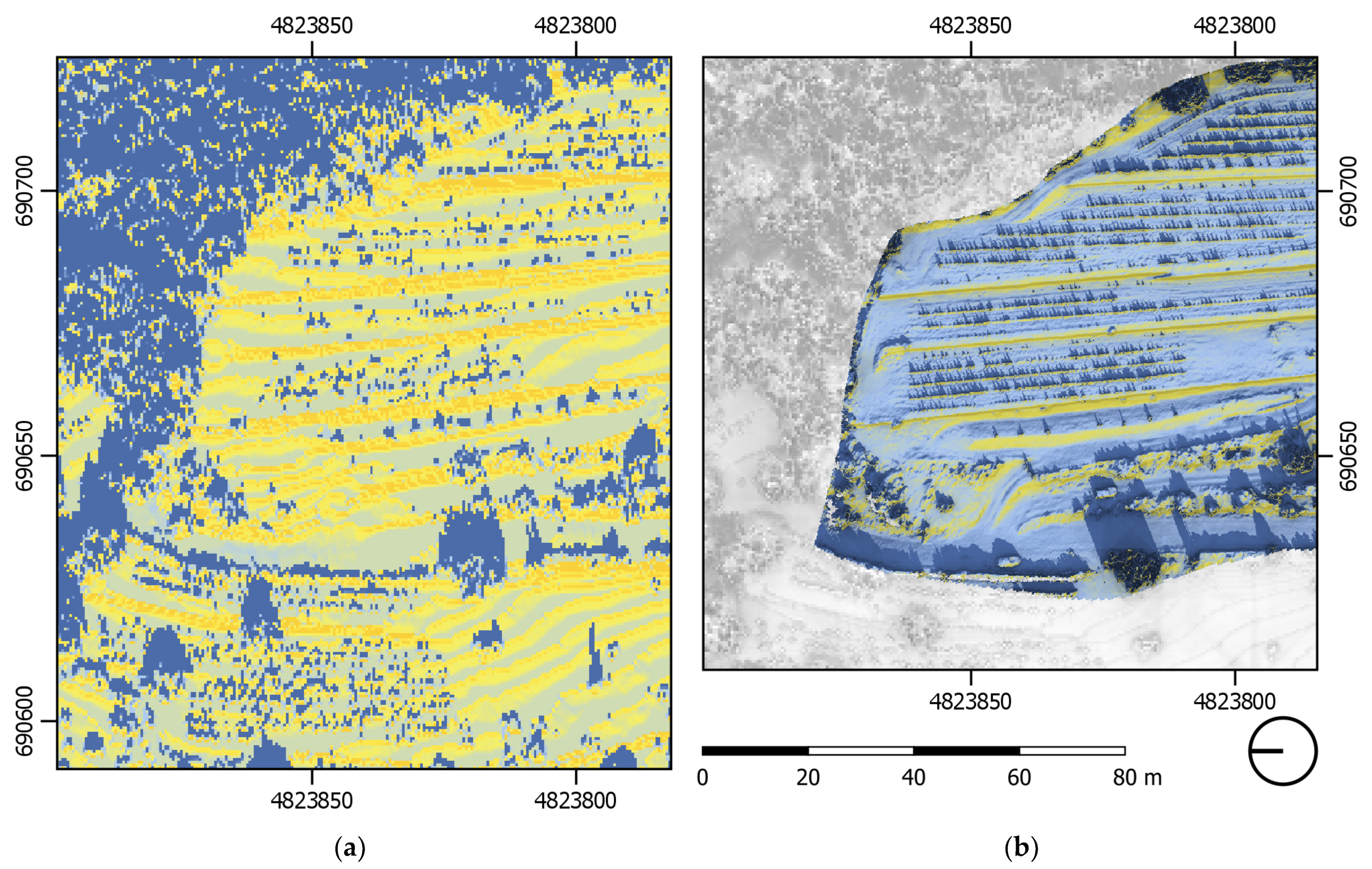
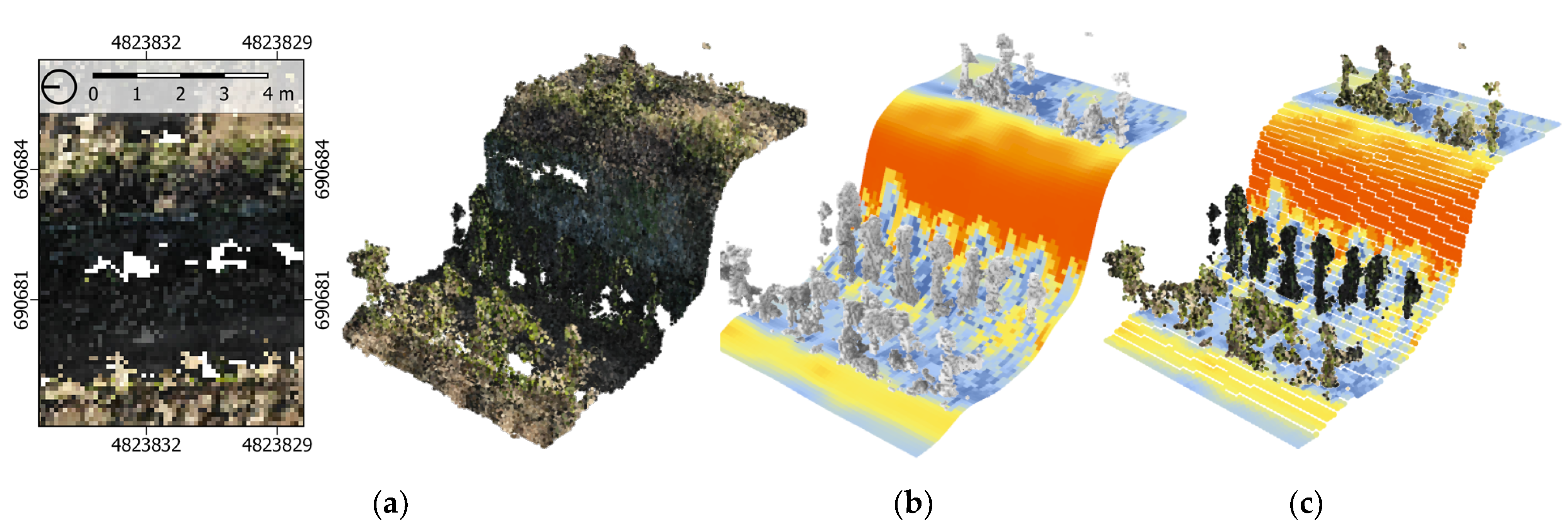
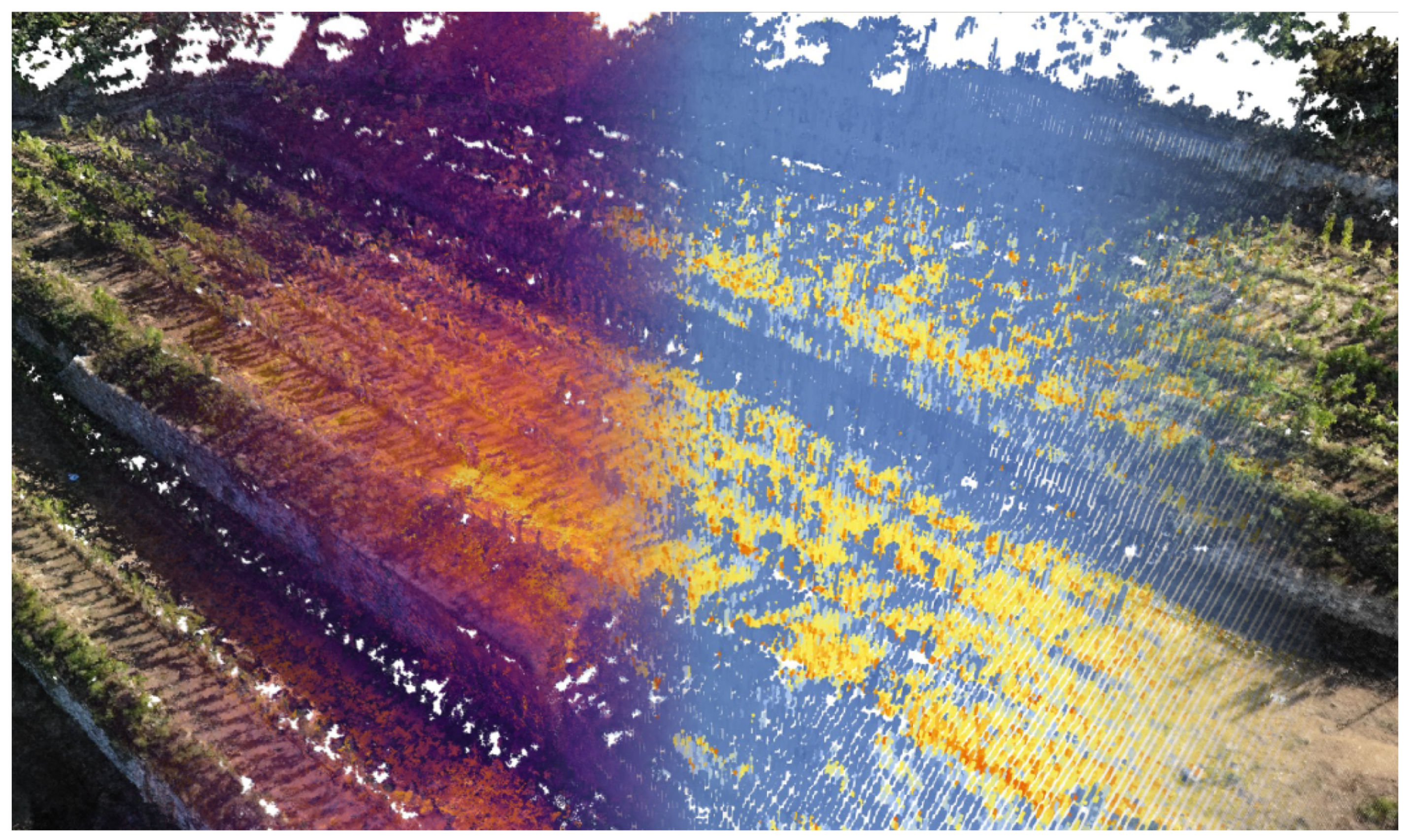
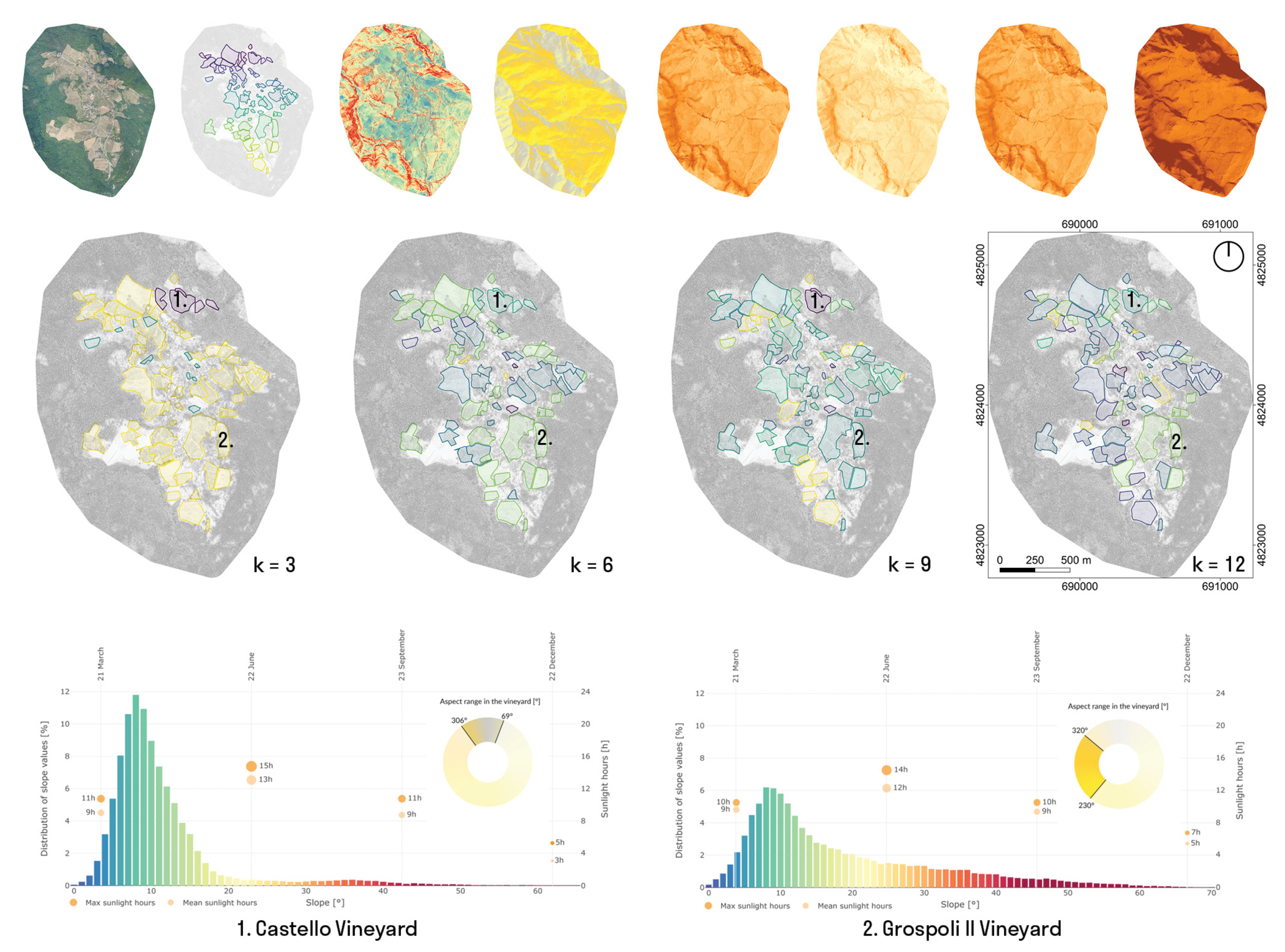
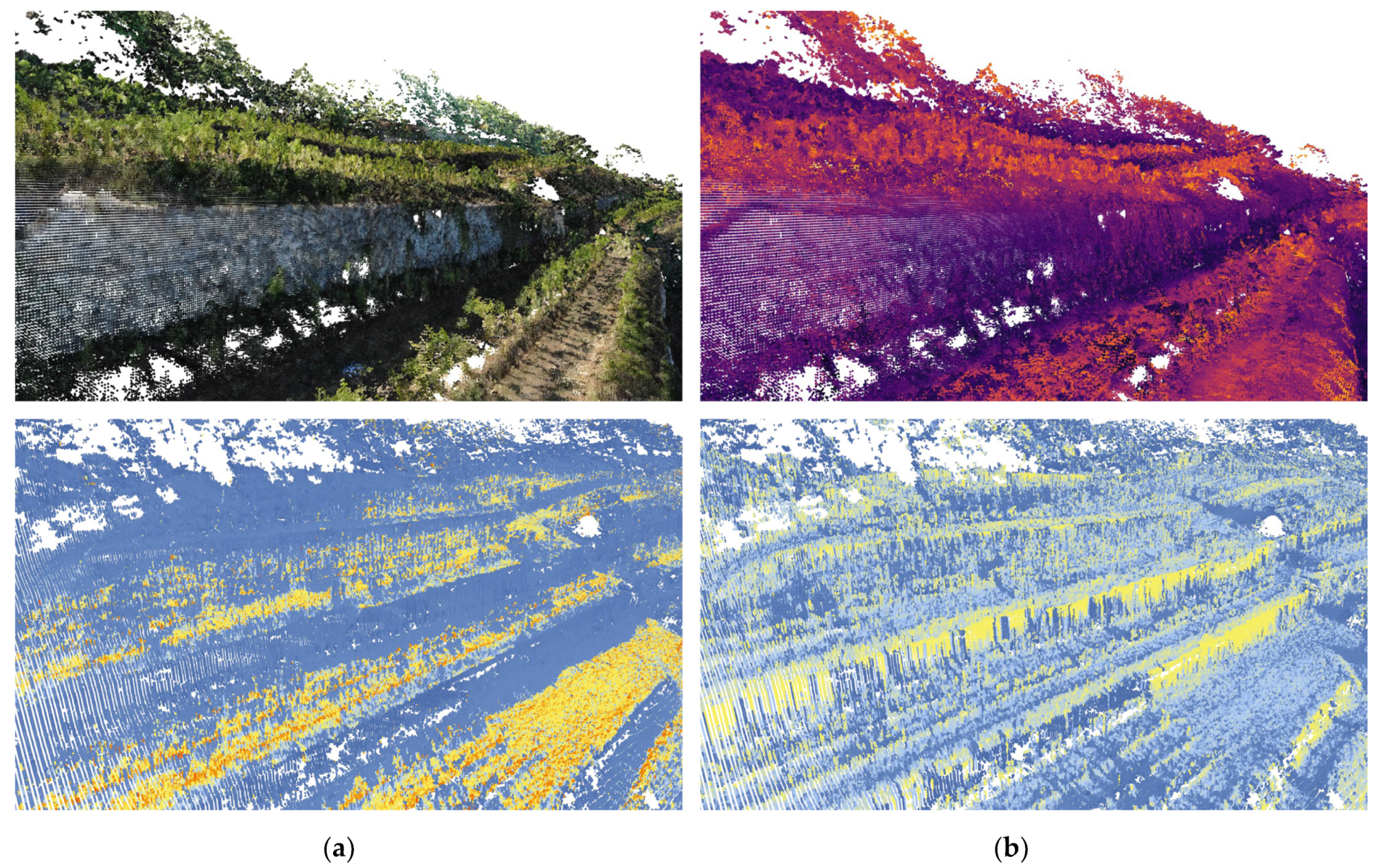


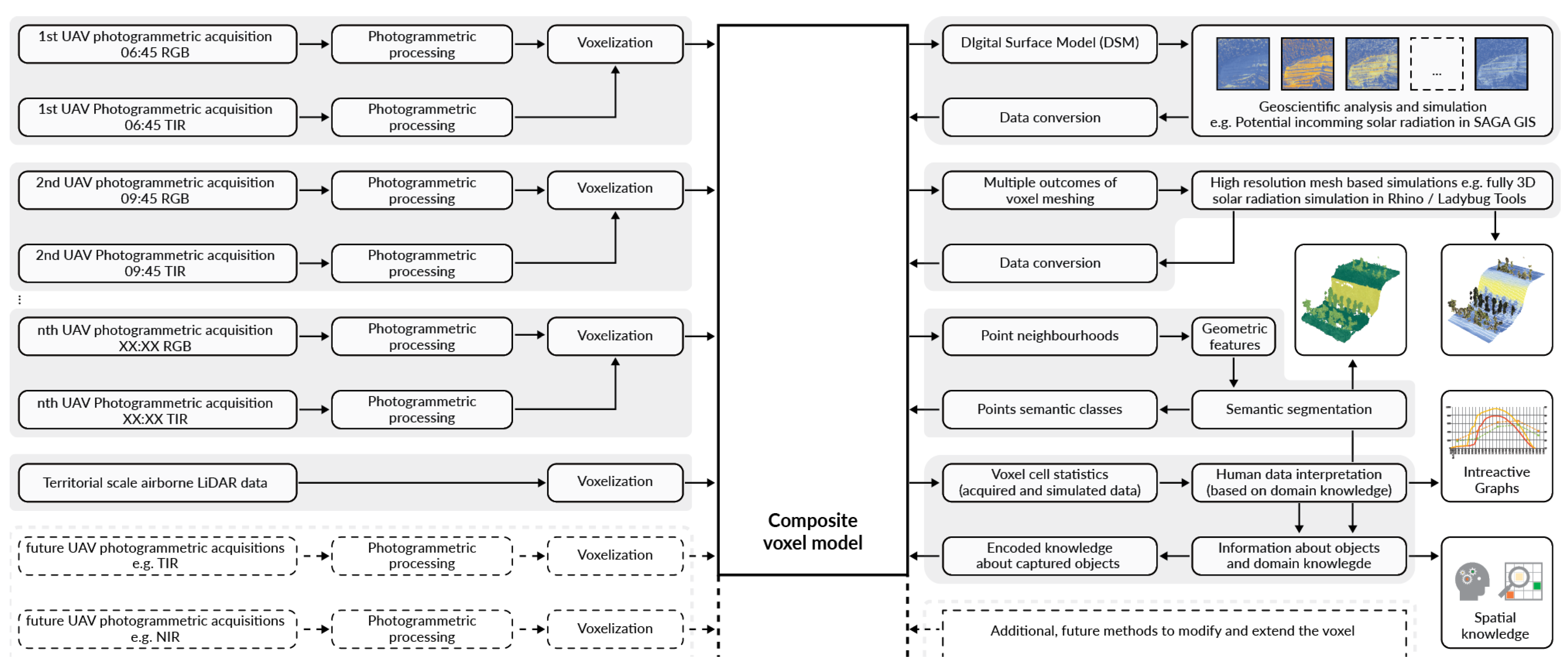
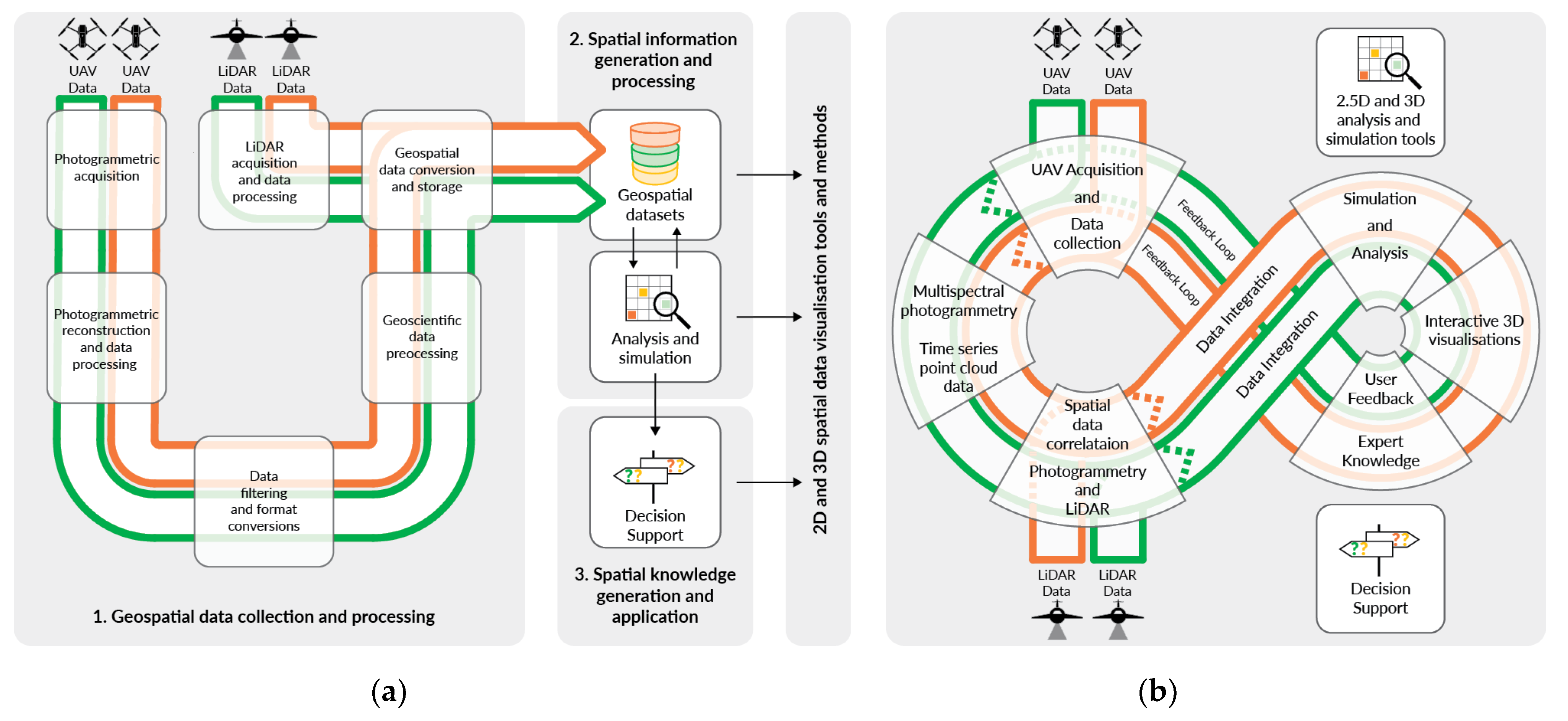
| Photogrammetry RGB | Photogrammetry TIR | Airborne LiDAR | |
|---|---|---|---|
| Spatial Resolution | 2 cm GSD | 4 cm IFOV @ 60 m | 50 cm GSD |
| Time series | 5 acquisitions per day | 5 acquisitions per day | - |
| Total number of points | ca. 215.000.000 points on average for 5 acquisitions | 15.569.983 points | |
| Total area covered | Grospoli II vineyard—1.1 ha | Lamole valley—341 ha | |
| Available data products | unclassified RGB point cloud | TIR temperature data encoded as a point cloud | classified LiDAR point cloud, DSM, DTM |
| Platform | DJI Mavic 2 Enterprise Dual | Vulcanair P68 B Victor | |
| Sensors | RGB: DJI M2ED 1/2.3″ CMOS; 12MP TIR: FLIR Lepton 3.5 160 × 120 px | LiDAR: Riegl LMS-Q680i | |
| Acquisition date | 5 September 2020 | 6 August 2020 | |
Publisher’s Note: MDPI stays neutral with regard to jurisdictional claims in published maps and institutional affiliations. |
© 2021 by the authors. Licensee MDPI, Basel, Switzerland. This article is an open access article distributed under the terms and conditions of the Creative Commons Attribution (CC BY) license (https://creativecommons.org/licenses/by/4.0/).
Share and Cite
Tyc, J.; Sunguroğlu Hensel, D.; Parisi, E.I.; Tucci, G.; Hensel, M.U. Integration of Remote Sensing Data into a Composite Voxel Model for Environmental Performance Analysis of Terraced Vineyards in Tuscany, Italy. Remote Sens. 2021, 13, 3483. https://doi.org/10.3390/rs13173483
Tyc J, Sunguroğlu Hensel D, Parisi EI, Tucci G, Hensel MU. Integration of Remote Sensing Data into a Composite Voxel Model for Environmental Performance Analysis of Terraced Vineyards in Tuscany, Italy. Remote Sensing. 2021; 13(17):3483. https://doi.org/10.3390/rs13173483
Chicago/Turabian StyleTyc, Jakub, Defne Sunguroğlu Hensel, Erica Isabella Parisi, Grazia Tucci, and Michael Ulrich Hensel. 2021. "Integration of Remote Sensing Data into a Composite Voxel Model for Environmental Performance Analysis of Terraced Vineyards in Tuscany, Italy" Remote Sensing 13, no. 17: 3483. https://doi.org/10.3390/rs13173483
APA StyleTyc, J., Sunguroğlu Hensel, D., Parisi, E. I., Tucci, G., & Hensel, M. U. (2021). Integration of Remote Sensing Data into a Composite Voxel Model for Environmental Performance Analysis of Terraced Vineyards in Tuscany, Italy. Remote Sensing, 13(17), 3483. https://doi.org/10.3390/rs13173483








